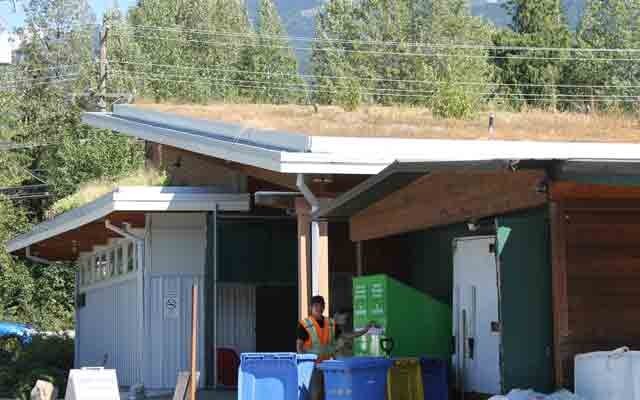Touted as a Green technology to keep buildings warm in the winter and cool in the summer while using less energy, the grass roofs of Whistler are looking decidedly yellow in the current dry, hot spell.
But this is not necessarily a problem, said the municipality and Whistler's fire chief.
Three prominent local buildings — The almost $12 million Whistler Public Library on Main Street, the Spring Creek Fire Hall and Whistler Animals Galore (WAG) animal shelter on the Sea to Sky Highway — all have the roofs and are looking a little worse for wear in the dry weather, which began in late June.
Green roofs work when rainwater is absorbed by covering plants, and then evaporates back into the air, as opposed to bouncing off a traditional roof surface. The grass also protects the roof membrane from ultraviolet light.
Whistler's fire chief Rob Whitton said the fire rescue service had been consulted when the roofs were being considered.
"Through that process we had input into the plants that would be used. They are Fire Smart compatible, meaning they hold a lot of moisture within them. At times they look a bit dry, but you have to take into consideration where they're planted, how they're planted and how the system works. From a fire perspective they are designed to retain as much water as possible for the plants to use during a drought period," he said.
A spokesperson for the Resort Municipality of Whistler said the library's roof irrigation system was used to water the plants until they were hardy enough to survive on their own. The fire hall's irrigation system has been in place since 2009, but has not been activated. WAG's roof does not have an irrigation system and relies on rain to water the plants.
The library building was given a LEED (Leadership in Environmental Design) point exemption because Whitton recommended keeping its irrigation system
Whitton said that while grass roofs are dry, any fire there would be very slow moving. He agreed the three roofs looked a little dry and rough but they require little or no maintenance. In case of a wildfire scenario, the roof could be quickly watered down to mitigate risk from sparks.
"The soil underneath the plants is not a peat-type soil, it's more a mineral-type soil. The roofs underneath are non-combustible," Whitton said. "The roots are working away to design, and the plants are taking advantage of that. Some do better than others but that's the way it works."
Whitton said that RMOW staff checking the roofs once a year would be sufficient, and the points used on the Whistler roofs were selected specifically for the current dry conditions.
Ryan Jones of WAG said they have been in their grass-roofed building for eight years and remembered a paw print outlined in purple plants being on the roof at the start, though it hasn't been there for several years.
Jones is not sure when the RMOW landscaping department last did direct maintenance on the roof.
"They've been around a lot this summer and I don't know their exact plans, but (they haven't been on the roof); not that I've seen," he said.
"It's a great feature to have. It definitely cools down the building, especially where the animals are kept. Definitely compared to our last shelter building, sometimes by 10 degrees. It's really noticeable in this weather," Jones said.
When asked about the cost vs. savings value of the roofs, which cost more to install compared to conventional roofs, a spokesperson for the RMOW said:
"The RMOW has not quantified cost/savings; however the best cost/savings are in a green roof's lifespan, which is typically double or triple the lifespan of a typical roof. Actual costs depend on the size of the roof and type of green roof build up.
"There may also be cost savings due to reduced storm water runoff, which means that smaller diameter pipes can be used to convey water away from a green roof."
Breakdown of the costs of the roofs during construction were also not available, the RMOW said.




